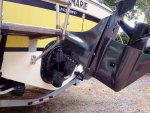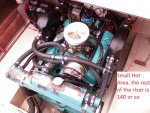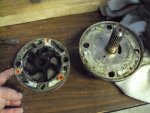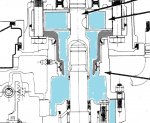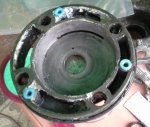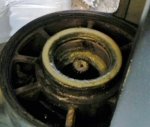This is a general question out to the OMC experts.
My engine is running great, but I'm always looking to be ahead of problems and keep a close eye on things.
I had the exchanger off when replacing my alt belt and water pump belt. Even replaced the circ pump (probably didn't need to) and repainted the pulley wheels that I had access to when the front engine mount was off.
So got all that done and during my outings this year I have taken the time to shoot the temp gun at various places on the motor to validate everything and to try to understand the accuracy of my temp guage on the dash.
Most temps taken seem to be in line with what to expect except one spot on the port riser. Measures 200+ at times during engine running, where the stbd riser in the same place may only be 140 to 160.
The temp at the thermo housing is right at 165. Some ares of the intake maifold are near 160, most less. Of course the exhaust manifolds are really hot, near 200 in most places, sometimes a little over.
Some of the issues I have battled over the years seem to be related to heat. So I'm watching that.
I took the port riser off and flused it clean with water it did have so flakes of crud in there. But after putting it all back together it still get's hotter than the stbd side.
Would any of you be concerned with your riser to elboow exhaust hose being in the 200 degree range.
FYI. the engine does not overheat.
Thanks.
FT
My engine is running great, but I'm always looking to be ahead of problems and keep a close eye on things.
I had the exchanger off when replacing my alt belt and water pump belt. Even replaced the circ pump (probably didn't need to) and repainted the pulley wheels that I had access to when the front engine mount was off.
So got all that done and during my outings this year I have taken the time to shoot the temp gun at various places on the motor to validate everything and to try to understand the accuracy of my temp guage on the dash.
Most temps taken seem to be in line with what to expect except one spot on the port riser. Measures 200+ at times during engine running, where the stbd riser in the same place may only be 140 to 160.
The temp at the thermo housing is right at 165. Some ares of the intake maifold are near 160, most less. Of course the exhaust manifolds are really hot, near 200 in most places, sometimes a little over.
Some of the issues I have battled over the years seem to be related to heat. So I'm watching that.
I took the port riser off and flused it clean with water it did have so flakes of crud in there. But after putting it all back together it still get's hotter than the stbd side.
Would any of you be concerned with your riser to elboow exhaust hose being in the 200 degree range.
FYI. the engine does not overheat.
Thanks.
FT




















